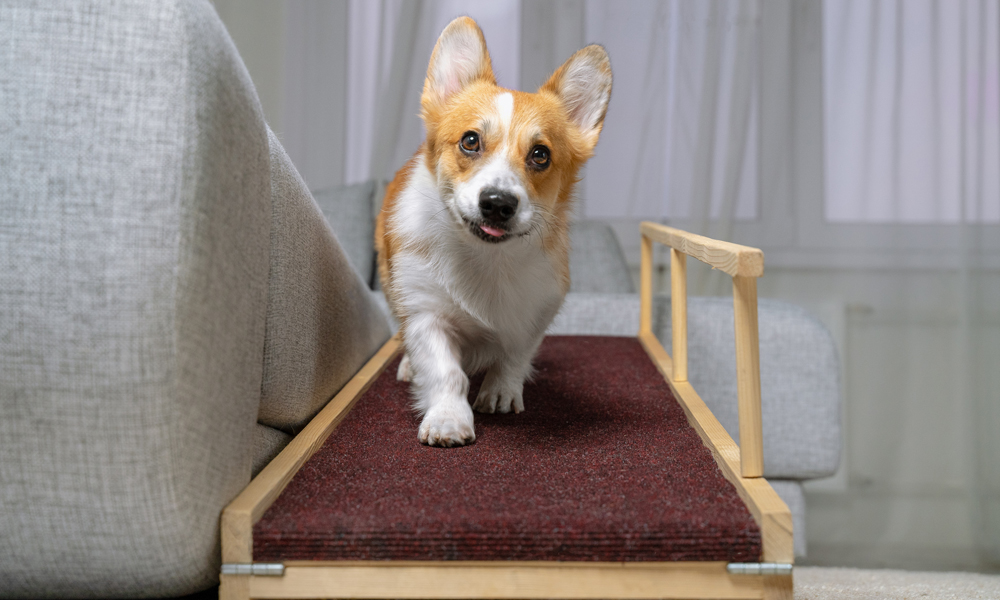Dogs think nothing of leaping up onto the bed, the sofa or into the car so they can get close to their favorite people. However, if your dog seems to need a lot more coaxing to join you, that’s a sign that making the jump is a painful prospect for your best friend. Or, if your dog’s short legs and small stature require Superman-like leaps, they could very well end up injuring a knee or paw, especially if they’re landing on a hard surface, like cement. Bottom line, jumping on and off a higher perch is a high-load activity that can be hard on your dog’s joints, causing inflammation or even injury. That’s where providing a ramp or a set of pet stairs can help your pet move about safely and comfortably.
Does your dog need stairs or a ramp?
Some dogs seem to have springs in their legs. But if any of these describe your dog, they’re likely an excellent candidate for a ramp or a set of pet stairs.
- Senior dogs, even if they haven’t slowed down yet, can develop arthritis.
- Dogs that are showing signs of hip or joint problems. Are they limping, or tucking a leg when they run and play? If you’ve noticed they need more coaxing than normal, it’s time to have them examined.
- Smaller dogs, especially if they’re constantly leaping to or from great heights.
- Dogs with long spines, such as dachshunds and corgis, can be prone to back injuries. Jumping can exacerbate these problems.
- Dogs that are overweight. The act of launching and landing can place extra pressure on a dog’s joints; add a few pounds, and that can set them up for injury.
- Dogs that are recovering from an injury in the paw, leg or hips.
Should dogs be allowed to jump?
Jumping in and of itself isn’t a bad thing. After all, when done safely, it can be great exercise, and it’s an event you’ll find on any dog agility course. There are two keys to safe jumping for healthy dogs: the height should be right for your dog’s size, with safe, skid-free surfaces that don’t provide a hard landing. Otherwise, jumping can lead to injury and joint conditions.
Arthritis happens when the layer of cartilage between two bones in the joints is damaged or worn away. It’s a natural effect of aging, and one in five dogs will develop arthritis in their lifetimes, according to the Rheumatoid Arthritis Support Network. Repeatedly jumping and landing to and from a too-high surface can absolutely cause the type of orthopedic trauma that leads to the early onset of arthritis.
Jumping can also cause torn ligaments, broken toes, strains, sprains and inflammation.
If jumping is painful for your dog, is it OK to lift them?
If your dog is in too much pain to leap up onto the couch or the car, make sure you’re lifting them without making it worse. Don’t grab them under the armpit area, as you would a small child, as that can also be painful. The best way to lift a dog is by placing one arm under the chest and the other under the rump, and then lift. If your dog is flinching or growling in response, your dog is in pain and you should stop. (Your dog’s vet or health care provider may have other suggestions for safe lifting.)
To safely assist a larger dog, you can try a lift harness, which distributes the pressure throughout the chest and abdomen area (while keeping pressure off the neck). Check with your local brick-and-mortar pet shop to find some great options.
How high is too high?
Wondering if the couch is too high for your small dog? Taking a look at maximum jump heights for dog agility courses can offer some guidance. What they do is take the dog’s size into account so there’s less risk of injury during training and competition.
First, measure the distance from the top of the dog’s shoulder blades to the ground, which is called the withers height. And then check out the corresponding maximum height recommended for jumping obstacles.
For example, a small dog with a withers height of 11 inches would jump over a hurdle that was no more than 4 inches off the ground, if you go by the guidelines set by the North American Dog Agility Council. A tall dog that’s 18 inches and above would jump no more than 16 inches.
Granted, completing a jump over an obstacle is not the same as jumping up onto a bed, a couch or a truck. But if coming down from a particular height is deemed unsafe on the agility course, why would it be safer on a living room floor or driveway?
Stairs vs ramp: Which is best for my dog?
Steps have the advantage of being more compressed in size than ramps, so they take up less space. If they’re parked on one end of the couch or bed, they won’t stick out nearly as much and cause a tripping hazard to the humans of the house. This also makes a stair set easier to transport and store when not in use. If your dog is healthy, and using the stairs isn’t painful, this can be a great option.
Ramps are easiest on dogs with joint or hip pain, as well as arthritis, as they can step rather than lift their knees, hips and shoulders as they would for a stair tread. They’re also best for dogs with short legs. But the important thing is making sure the angle of the ramp is low enough for your dog to get around painlessly. (A too-steep incline won’t do much good.)
Whichever option is best for your dog, be sure and shop at your independently owned pet supply shop to find what works best for your pet. Here are a few considerations while you shop.
- Look for an anti-skid surface, so your dog doesn’t skid or slide.
- Proper width is crucial to safe stepping, so make sure it’s wide enough for the largest dog in your home.
- A grip for the bottom of the ramp or stairs will keep the structure from sliding while in use.
- Choose the right slope for your pet. If your dog has to work hard to make his way up, a lower angle will be a better, painless option.
As your dog ages, choosing the right diet can help your best friend look and feel their best. NutriSource Senior Recipe comes in yummy chicken, is lower in fat, and is supplemented with Omega-3 fatty acids, which can help reduce the inflammation and pain that come with canine arthritis. Not to mention, it’s heart-healthy! For a long and healthy life, find NutriSource at your local, independent pet retailer.


